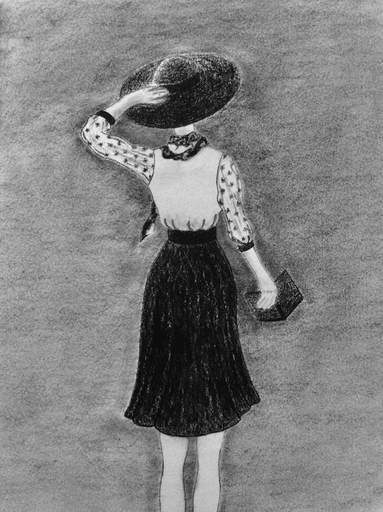Stand before a 1933 mural in Morelia, Mexico. Wonder at the images of Purépecha women wrapped in rebozos, the fishermen bent over butterfly nets on Lake Pátzcuaro. Marvel that you’ve never seen this painting through twenty years of visiting Michoacán. Register that spine tingling jolt that art delivers when viewer and artist unite across time. Ask the guard for the muralist’s name. Fight chagrin that you assumed it was a man - one of the “Three Greats” – Diego Rivera, José Clemente Orozco, David Alfaro Siqueiros. Listen to the call of the dead as Marion Greenwood’s life overtakes your own.
Put aside the book of essays you vowed to finish this year. Overcome the rational warning about biography: that it will send you into a mine shaft of endless work, a labyrinth without exit, a money drain no publisher’s advance will cover.
Remember your childhood joy in reading the little orange biographies of Clara Barton and Amelia Earhart, how these ranked supreme among the few books in your 1950s childhood home. Smaller than the unwieldy Encyclopedia Britannica and the Readers Digest Condensed books, here were stories of real heroines. Recall (vaguely) that the series included men’s lives. Commemorate the women.
Lose yourself in archives, websites, and libraries. Send queries like bottles onto a vast sea. Discover that Greenwood was the first woman to paint a mural in Mexico, someone once so important that the Museum of Women in the Arts calls her “one of America’s greatest twentieth-century women artists.” Register how her paintings celebrated the dignity of working people in Mexico, Haiti, Hong Kong, and Trinidad. Wonder how she made a living as an artist in an era when few women could. Question why she has been largely forgotten.
Harness your anger when the first art historian you interview in New York dismisses her as a “femme fatale.” Agree with her friend and fellow artist who suggested Greenwood’s great beauty may have been “a handicap.” Grasp that she wouldn’t have been damned for her freewheeling sexuality had she been a man. Bear in mind that women artists have been forgotten or disregarded for as long as human beings have made art.
Feel your pulse quicken at every lead to someone who might fill your recorder with memories of Greenwood. Stay excited until you’ve exhausted your funds on nonrefundable airline tickets to far-flung places to interview people who suddenly remember they must leave town. Decide that they really aren’t that sorry.
Discover a wealthy collector obsessed with Greenwood who has traveled the world to amass her paintings, lithographs, voluminous letters and papers. Celebrate your good luck! Feel your spirit sink when he refuses to share that bounty or even speak to you. Rail at this hoarding of knowledge. Remember reading Andre Gide’s damnation of those who seek knowledge “to bore, oppress, and terrorize their neighbors.” Be grateful that you teach with generous colleagues, certain that the gift grows as it changes hands, that this exchange is the basis of culture. Wonder if some collectors use acquisition to fill a deep emptiness.
Admit that biographers may share this illness, consumed by a life not their own. Disregard Janet Malcolm’s view of the biographer as busybody and burglar. Ignore that Henry James once created a secret drawer to outwit voyeurs seeking the letters he had already burned. Dismiss those who scorn your sniffing after vague scents and leads. Know that what you seek is to feel the pulse of another life, to get outside your own skin, your constricted time and place. Accept that readers and critics might applaud your work (all that time in archives!), but still ignore the writing itself, assuming that a fact-crammed tome equals a story.
Guard against blurring the boundaries of writer and subject. Allow that though your history shares something with Greenwood’s – Irish ancestry, natal families of six children, a certain spirit of rebellion - you are radically different. But when you read her husband Robert Plate’s journals, release your tears. Feel his anguish in recording the cerebral hemorrhage that left her in a coma-like state. Ruminate on the entries where he prayed she would die. When he could not face that she would die. When he considered something worse: an endless purgatory of almost life. Ponder the day in 1970 when Plate finally wrote that Marion was gone. Because you love someone that intensely, feel the shattering of lives across a half-century and thousands of miles. Bow before the dark, universal claim death makes.
Banish hope that the wealthy collector will suddenly grow generous. Fantasize that his so-called trove may actually be a Henry James secret drawer. Laugh at the thought! Understand, finally, that you don’t need his mountain of materials. Salute the writer as bricoleur, creating coherence from assembled shards, finding liberation in the gaps and silences. Return to Greenwood’s mural to ponder how she, too, faced limitations, culling from her sketches to tell a complex story on a single wall. Celebrate the artist’s freedom to mix knowledge and imagination.
Embrace the impossibility of your task.
Pick up your pen.
Joanne B. Mulcahy teaches creative nonfiction at Lewis and Clark College and the Center for Documentary Studies at Duke University. Her essays appear in numerous journals and anthologies including The Stories that Shape Us: Contemporary Women Write About the West; These United States; and The Writer's Chronicle. She is author of Birth and Rebirth on an Alaskan Island; Remedios: The Healing Life of Eva Castellanoz; and Writing Abroad: A Guide for Travelers (with Peter Chilson). She is currently working on a biography of twentieth-century artist Marion Greenwood.

